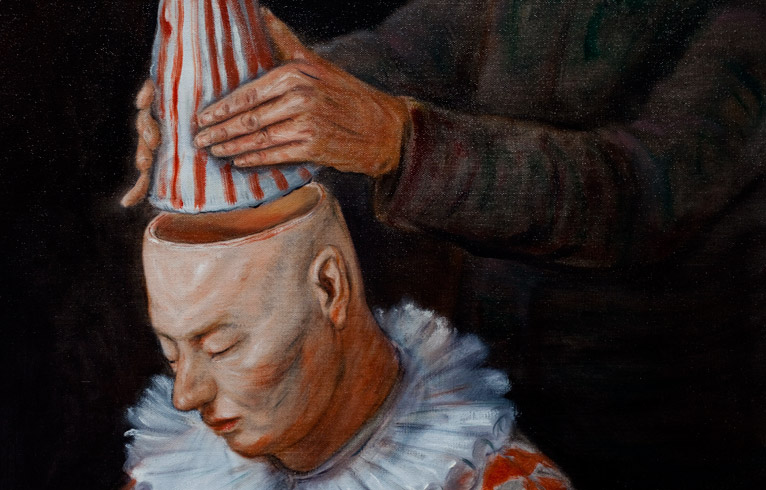WU JUNYONG: CLOUD’S NIGHTMARE
| March 24, 2011 | Post In LEAP 7

The telling and re-telling of fables, tall tales, and mythologies can conjure visions at once delightful and terrifying. Too often the fantastic becomes grotesque, the mystical monstrous, and the everyday surreal. Wu Junyong’s recent show dips into the horrible pleasures of the misread idiom, deploying image-symbols of downtrodden clowns, cranes, textless books, flutes, and pointed hats into otherworldly realms spotted with blood and fire. When situated within vastly empty landscapes, this iconography, if at times simplistic, suggests a contemplative albeit cynical perspective—one of youth, perhaps, or of an artist still playing with ideas and forms who has graciously opened his sketchbook to us. The result is a gallery showing that, while not entirely convincing, is at moments compelling, and should signal Wu as an artist to watch in the years ahead.
Wu Junyong was trained as a printmaker but pursued his graduate work in new media at China Academy of Art in Hangzhou, where he is now an instructor. He mentions being inspired by the work of Pieter Bruegel the Elder and Albrecht Dürer, masters of paint and print. Formally, though, there is an utter disconnect. Bruegel’s allegorical paintings and Dürer’s woodblock prints are compositionally full and rendered with precision. Wu’s paintings are messy and hastily executed, lacking the lush colorwork and use of the frame of the masters. Thematically, however, the artists offer Wu very specific objects of study: Bruegel’s Netherlandish Proverbs (1559), a painting loaded with illustrations of perhaps 100 idioms used at the time; the blackened backgrounds of Dürer’s portraits; and the demon-laced imagery in Dürer’s famous woodblock print series, Apocalypse (1498). Let’s not forget the peasants, either, though Wu likes his a bit dim, akin to those in Bruegel’s The Blind Leading the Blind (1568).
Wu Junyong does not attempt to address his subjects in the broadly masterful way of his idols, and instead focuses on his idiomatic explorations of Chinese parables one or two at a time. Peasants, dragons, spiders and everyday objects populate the purgatory of Wu’s canvases and diorama-like reliefs. These painted figures are familiar. The men with pointed caps— are they wizards or dunces?—play big roles in Wu’s animations, as do brainless, sad-faced clowns, dead deer, impossible two-player flutes, and long, pointed objects, like the beaks of cranes, walking sticks, and extended fingers. They exist in hellish terrain, though, both as depicted (think blood-soaked tile floors and headless dragons writhing on long-legged chairs) and as rendered (the brushwork is decidedly fast, the color mixing almost absent, the painted surface thin, and the woodwork choppy). Collectively, the paintings offer a tangible context for Wu’s animated piece Cloud’s Nightmare. The video uses similar themes and symbols as in the paintings, but in the video these figures are blackened silhouettes. The human figures are by and large men floating through a cloud-filled sky: men at work, pulling kite-like devices and ropes, men wearing dunce-wizard caps, men sitting in chairs with long legs that walk. The men are accompanied by a surge of animalia: donkeys, spiders, headless horses, roosters, spiders, and storks. Sometimes the men ride these creatures, and sometimes they spar. At times the human figures move like shadow puppets, their puppet strings visible, while dark birds fly overhead. The video concludes with an ark-like explosion of animals in the sky, and a smoking, empty chair, which floats, then falls from the sky. The animations are beautiful, if imperfect. For Wu Junyong, painting serves as a momentary escape from the tedium of digital animation. But the dark weight of the subjects he investigates – which portray a social critique of his country and his brethren—seem somehow better served by the visceral nature of paint and the dimensional surfaces of mounted canvas and carved wood. Unlike the vivid, forceful detail of, say, Kara Walker’s silhouettes, Wu’s are aimless, wandering figures, and we do not know their purpose, their place, nor do we have any sense of their feeling. Juxtaposed against paintings clearly awash in the latter, I think I prefer my melancholic circuses in color. Mara Gladstone

